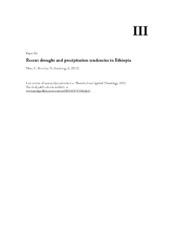Recent drought and precipitation tendencies in Ethiopia
Peer reviewed, Journal article
Accepted version
Permanent lenke
https://hdl.handle.net/1956/6262Utgivelsesdato
2013-05Metadata
Vis full innførselSamlinger
- Geophysical Institute [1187]
Originalversjon
https://doi.org/10.1007/s00704-012-0746-3Sammendrag
In 2011, drought in the Horn of Africa again made news headlines. This study aims to quantify the meteorological component of this and other drought episodes in Ethiopia since 1971. A monthly precipitation data set for 14 homogeneous rainfall zones was constructed based on 174 gauge observations. As a measure of drought, the Standardized Precipitation Index was calculated on seasonal, annual and biannual timescales for each zone. The results point to 2009 as a year of exceptionally widespread drought. All zones experienced some degree of drought at the annual scale, although in most zones, previous droughts were more extreme. On the national level, 2009 was the second driest year in the period, surpassed only by the historic drought year 1984. Linear regression analysis indicates a general decline in precipitation in southern Ethiopia, during both February–May and June–September. In the central and northern highlands, the trend analysis did not provide evidence of similar tendencies. However, spring droughts have appeared more frequently in all parts of Ethiopia during the last 10–15 years than during the previous decades.
